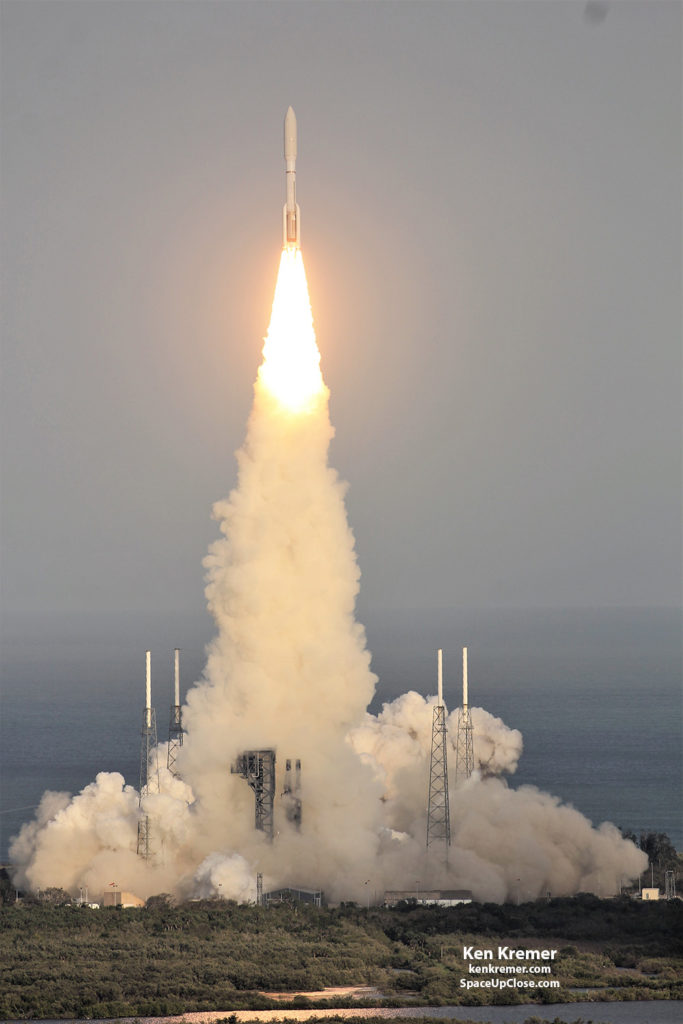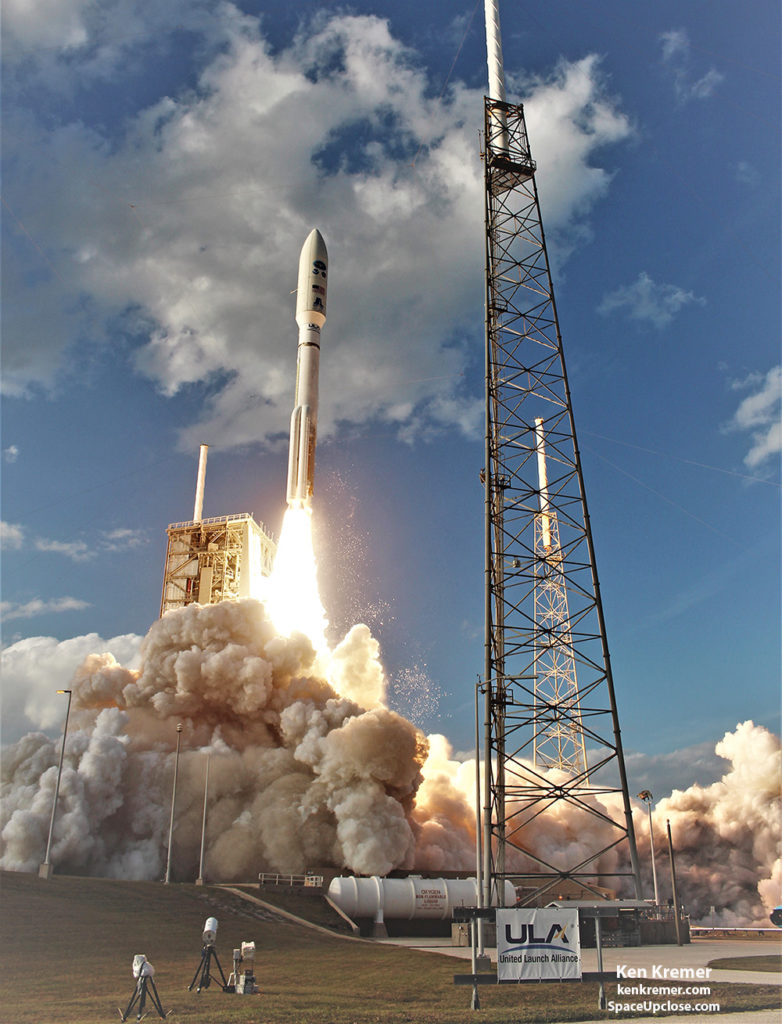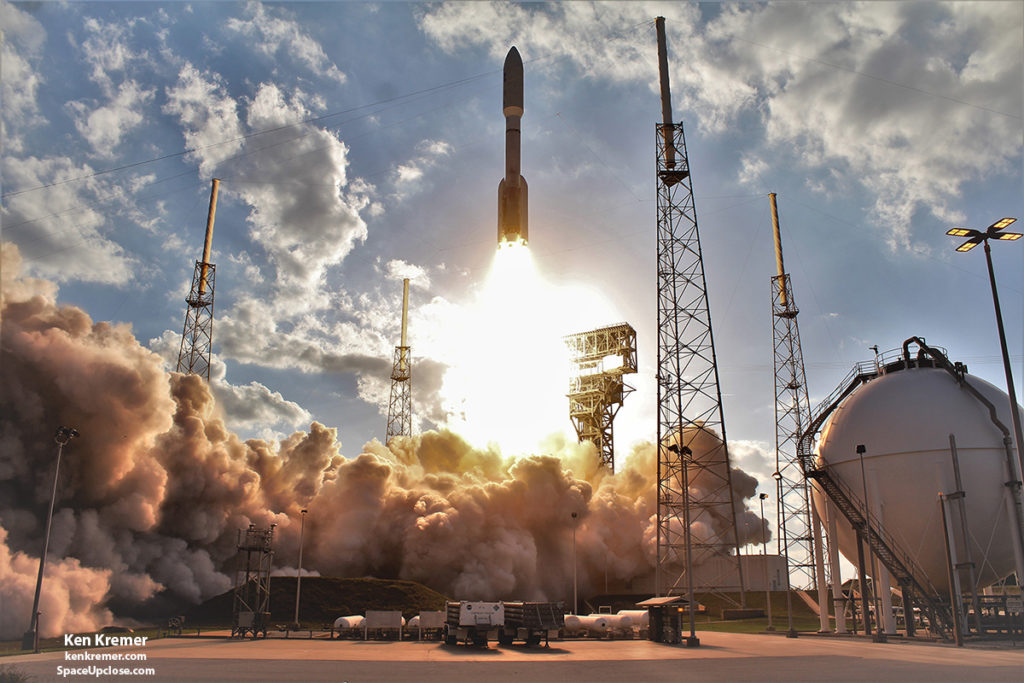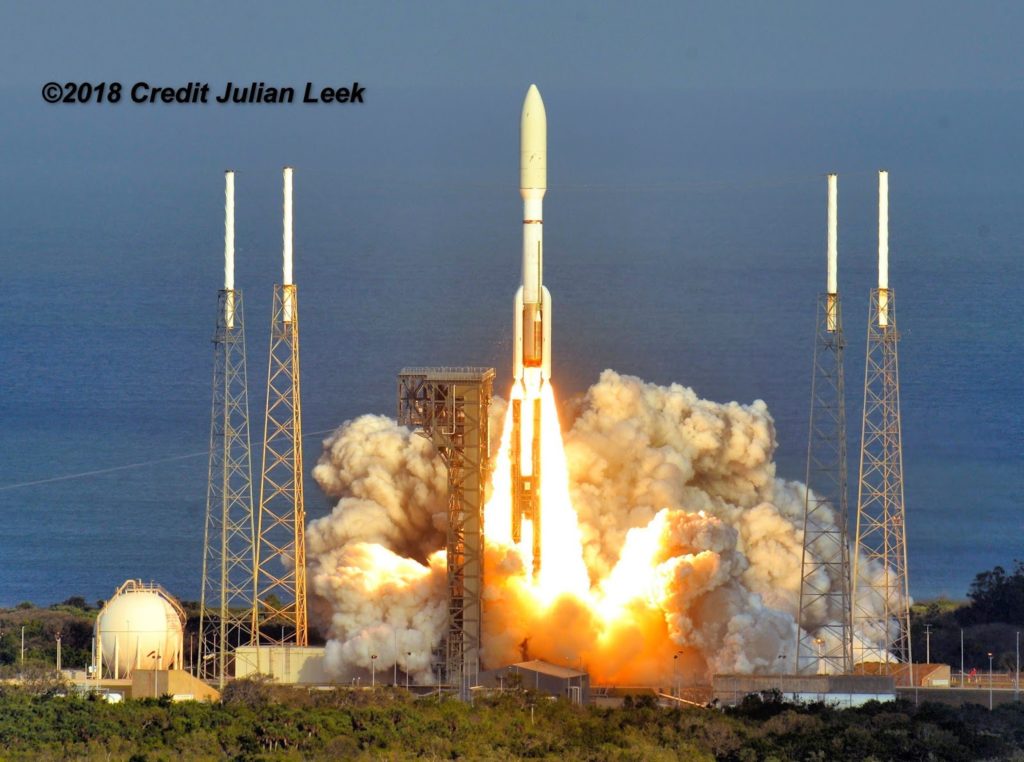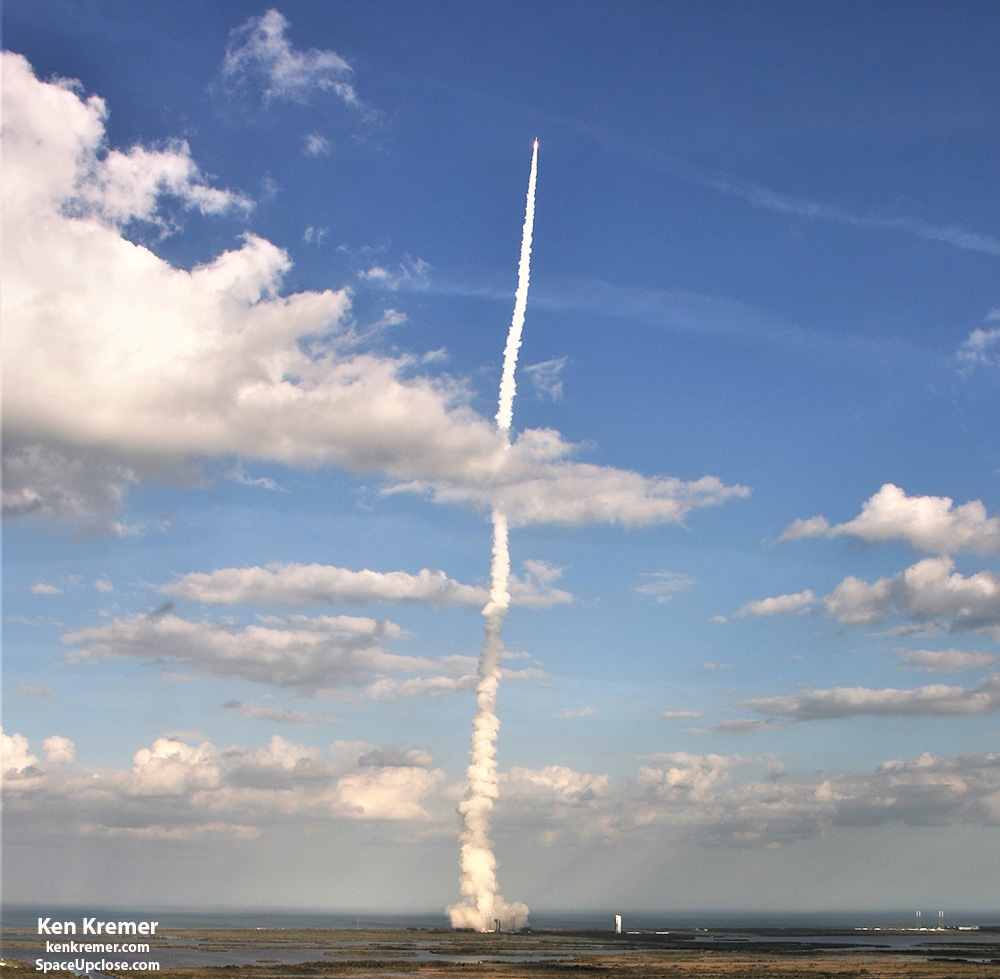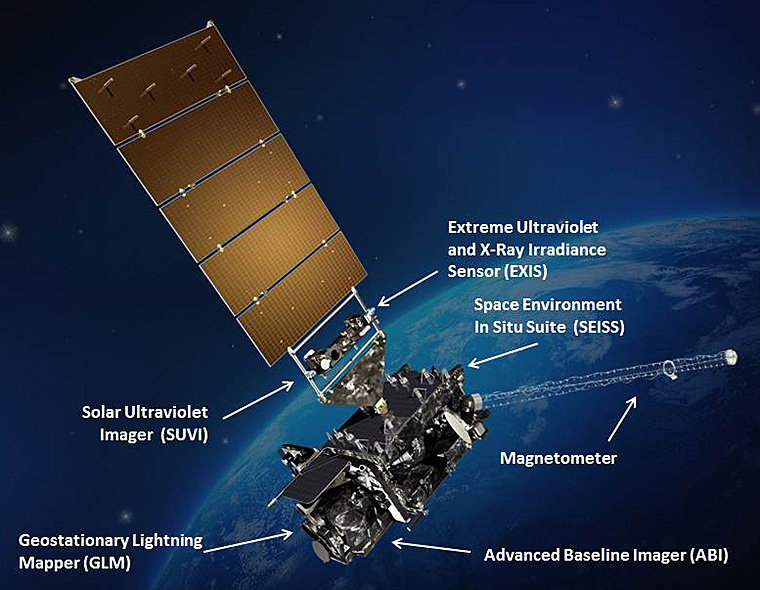CENTER, FL – The second in a series of next generation NOAA/NASA geostationary
weather observation satellites was launched on a ULA Atlas V near sunset today,
Thursday March 1, in an awesome display or rocketry and science that will also revolutionize
weather forecasting in
the Western Hemisphere.
satellite launched today will provide vastly improved forecasts and warnings on
weather, wildfires, tornadoes and cyclones for California and the western United
States all the way out to Hawaii and Guam in ways that will positively impact
the lives of everyday people as well as save lives by helping pinpoint outbreaks
of severe weather in near real time.
Satellite-S (GOES-S) lifted off in picture perfect fashion on a United Launch Alliance (ULA) Atlas V
rocket from seaside Space Launch Complex 41 at Cape Canaveral Air Force Station
in Florida at 5:02 p.m. EST.
with 2.25 million pounds of liftoff thrust generated by the first stage solid
and liquid fueled engines and put on a spectacular sky show soaring to orbit
atop a tremendous exhaust plume of smoke and ash originating from America’s
premier spaceport.
around the globe lined sandy beaches and packed parks, restaurants, roads and viewing
locations ringing the Kennedy Space Center- and they were all thrilled to
witness history in the making.
solid rocket boosters were jettisoned at 1 minute 50 seconds after liftoff
when their fuel was expended and atop the rising exhaust plume.
above the earth’s atmosphere.
generating solar arrays deployed as planned came at 8:58 p.m. ET nearly four hours
after launch and the team heaved a collective sigh of relief.
a quantum leap in weather forecasting for the western United States just as
GOES-R – the first satellite in the new series – is now doing for the eastern United
Stated since it only recently became operational in December 2017.
“We at NASA Science are proud to support our
joint agency partner NOAA on today’s launch of GOES-S, a national asset that
will impact lives across the Western Hemisphere each and every day,” said
Thomas Zurbuchen, NASA associate administrator for science, who attended
today’s launch.
accurate and more detailed data, in near real-time, to track storm systems,
lightning, wildfires, coastal fog and other hazards that affect the western
United States.”
foot tall Atlas V
propelled GOES-S into an initial geosynchronous transfer orbit on its way to geostationary
orbit soaring some 22,200 mi (35800 km) above Earth where it will operate for
the remainder of its planned 15 year lifetime.
launched every GOES satellite on current
and heritage Atlas and Delta rockets since the first mission lifted off in 1975.
the GOES-S spacecraft was delivered to its initial elliptical orbit,” Tim Gasparrini, GOES-S program
manager for Lockheed Martin, told Space Up Close during a post launch interview
today, March 1, at the KSC press site.
by prime contractor Lockheed Martin Space Systems, Littleton, Colorado.
Geostationary Operational Environmental Satellite–S, is a new and advanced
transformational weather satellite that will vastly enhance the quality, speed
and accuracy of weather forecasting available to forecasters for Earth’s
Western Hemisphere after it becomes operational later this year.
orbit GOES-S will be renamed as GOES-17/GOES West.
“GOES 17 will become operational in the fall of 2018,” Tim Walsh, acting GOES-R system program director at NOAA told Space UpClose during an interview at KSC. “It will give us the equivalent perspective for the western US that we
now have for the eastern US using the six onboard instruments namely ABI and
GLM, SUVI, EXIS, SEIS and the magnetometer.”
GOES-R series of America’s most powerful and most advanced next generation geostationary weather observation
satellites. It is designed to last for a
15 year orbital lifetime and will deliver a ‘quantum leap’ in weather
forecasting.
sister satellite GOES-R which was successfully launched by a ULA Atlas V on Nov. 19, 2016.
the GOES-R series consists of a quartet of four
identical satellites – comprising GOES-R, GOES-S, GOES-T and GOES-U – manufactured at an overall cost of about $11 Billion. This will keep the GOES satellite system operational through 2036.
science suite includes the Advanced Baseline Imager (ABI), Geostationary Lightning Mapper (GLM),
Solar Ultraviolet Imager (SUVI), Extreme Ultraviolet and X-Ray Irradiance Sensors
(EXIS), Space Environment In-Situ Suite (SEISS), and the Magnetometer
(MAG).
primary instrument and will collect 3
times more spectral data with 4 times greater resolution and scans 5 times
faster than ever before – via the primary Advanced Baseline Imager (ABI)
instrument – compared to the current GOES satellites.
channels in the visible, near infrared and infrared channels compared to 5 for
he legacy GOES satellites.
with 4x better spatial resolution, 3 x as many frequencies or spectral bands,
and we receive images 5 x faster,” Walsh said already with GOES-R/GOES-16
compared to the legacy GOES East/West satellite imager technologies “which were
created and developed in the mid-1980s.”
current imager on orbit today takes 26 minutes. With GOES-R now we can do the
same thing in 5 minutes.”
now weather forecasting imagery.”
May, said Walsh. “First we need to raise the temperature of the instruments
once on orbit. We will outgas them for several weeks.”
GOES-S/GOES 17 and GOES-R/GOES 16.”
equatorial belt to obtain different views.
Together they will be able to image the entire US and regions further
out beyond to the east and west to provide coverage of the entire Western
Hemisphere.
have from GOES 16.”
the eastern pacific. So at that time we will be able to see the entire United
States out to Hawaii, Alaska and even almost to New Zealand.”
gives the full Eastern seaboard and CONUS [continental US] coverage,” Walsh
explained.
12.8 ft) with a three-axis
stabilized spacecraft bus.
(11,446 lbs) at launch.
in the very powerful 541 configuration with the satellite shrouded in a two
piece payload fairing
5 meters (16.4 feet) in diameter.
is powered by the Russian built duel nozzle RD
AMROSS RD-180 engine that delivers 860,000 pounds of sea level thrust and is fueled by liquid
oxygen and RP-1 highly refined kerosene. It is augmented with four strap on AJ-60A solid rocket motors provided by Aerojet
Rocketdyne that deliver 348,000 pounds of thrust.
It measures 12.5 ft in diameter and 106.5 ft in length
powered by a single-engine Aerojet
Rocketdyne RL10C engine that is fueled with liquid oxygen and liquid hydrogen
and produces 22,900 pounds of thrust. It measures 10 ft
in diameter and 41.5 ft in length.
launch employing the 541 configuration.
“Thank you to our
partners at NASA and NOAA for the outstanding teamwork, as we delivered this
next-generation satellite to orbit,” said Gary Wentz, ULA vice president of
Government and Commercial Programs. “We are proud to serve as the ultimate
launch provider, continuing our dedication to 100 percent mission success.”
Overall this
was the 76th launch of the
Atlas V rocket, ULA’s 3rd launch in 2018 and the 126th successful launch
since the company was formed in December 2006 as a joint venture between Boeing
and Lockheed Martin.
Watch this launch
video compilation:
Video Caption: COMPILATION Views / GOES-S
Launches atop ULA Atlas V Rocket on March 1, 2018 from CCAFS pad 41.
Credit: Jeff Seibert
ULA, Boeing, Lockheed Martin, Orbital ATK and more space and mission
reports direct from the Kennedy Space Center and Cape Canaveral Air Force
Station, Florida.
Earth and Planetary science and human spaceflight news: www.kenkremer.com –www.spaceupclose.com –
twitter @ken_kremer – ken
at kenkremer.com
weather satellite launch and upcoming/recent SpaceX Falcon Heavy and Falcon 9 Hispasat, GovSat-1 launches on
Jan. 30 & Feb. 6, Mar 6, NASA missions, ULA Atlas & Delta launches,
SpySats and more at Ken’s upcoming outreach events at Kennedy Space Center
Quality Inn, Titusville, FL:
launch, SpaceX Falcon Heavy & Falcon 9 launches, ULA Atlas USAF SBIRS GEO 4
missile warning satellite, SpaceX GovSat-1, CRS-14 resupply launches to the
ISS, NRO & USAF Spysats, SLS, Orion, Boeing and SpaceX Commercial crew
capsules, , OSIRIS-Rex, Juno at Jupiter, InSight Mars lander, Curiosity and
Opportunity explore Mars, NH at Pluto and more,” Kennedy Space Center Quality
Inn, Titusville, FL, evenings. Photos for sale


